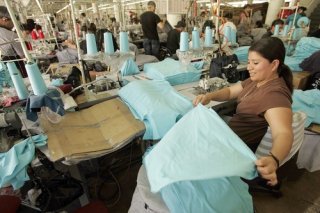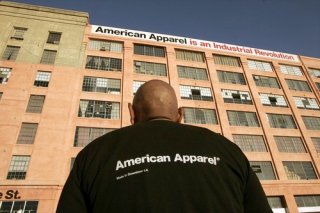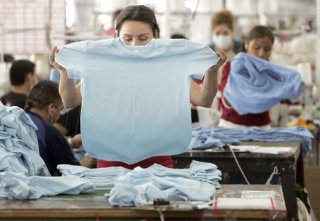U.S. clothing firm seeks good fit in China
Los Angeles Times Staff Writer
April 3, 2008
A local clothing maker is putting a new spin on a sore subject: American Apparel Inc. is opening stores in China this spring, and stocking them with T-shirts, shorts and hoodies made in downtown L.A.
Talk about going against the tide: One-third of the clothes sold in the U.S. come from China. Just 6% of the things we wear are made here.
Taking T-shirts stitched in L.A. to consumers in Beijing, Shanghai and Suzhou would fit American Apparel's business plan. The company has carved a niche in the last 10 years cranking out casual clothes in the Los Angeles warehouse district, where a banner atop the factory reads -- in red letters -- "American Apparel is an Industrial Revolution."
It's more efficient and less expensive to source from one country than from multiple sites, as many other companies do, Chief Executive Dov Charney said, and importing products from a collection of nations involves more headaches and costs.
"Made in the USA," he said, "becomes a competitive advantage."
Charney said the company would pay sales clerks in the Chinese stores hourly wages exceeding the U.S. minimum of $5.85, which in some parts of China is more than a worker makes in a day.
"There's not an employee of American Apparel that makes below the U.S. minimum wage," he said. To get "well-manicured" people who understand a brand, "you're going to have to pay," Charney said. "We're hiring American Apparel employees. We want them to be part of our corporate family."
Cai Yanchao, who sells clothes at Hot Wind, a shop in central Shanghai, said she would jump at $5.85 an hour. It "sounds like a lot to me," said the 19-year-old who makes the equivalent of about $214 a month, including commission, and whose employer pays for food and housing. (American Apparel won't do that.)
She had never heard of American Apparel, and neither had Sandra Zheng, a 25-year-old communication specialist who works for the Shanghai branch of a U.S. bank.
"I only know that brands like Tommy and Polo are American ones, right?" said Zheng, who makes about $3,000 a month and spends $286 to $429 of it on clothes.
"If it is the style that I like, I might consider visiting when it is open," Zheng said.
There's no guarantee that the Chinese will warm to American Apparel's basic, logo-free, no-glitz offerings as they have to loftier brands, such as Louis Vuitton and Gucci, and trendy lower-priced fashions from Hennes & Mauritz or Zara.
Charney acknowledged the challenge. American Apparel sells understated, "well-designed basics" while luxury goods are a "bit bourgeoisie and nouveau riche," he said. But "the young people tend to like Audi better than the Bentley, so maybe it can work."
Nor is it clear that the company's sexually charged marketing will fly in a country run by the Communist Party.
"They obviously need to have local marketing advisors and they need to proceed cautiously," said Doug Hart, a partner in professional services firm BDO Seidman's retail and consumer products group. "A lot of what happens in business regulation in China is relatively local."
Marketing has fueled American Apparel's success. Its ads typically feature average-looking people, often in skimpy attire or provocative poses. The message: You don't need to be fancy or beautiful to be cool and sexy.
The company has been politically provocative, running ads supporting undocumented workers that say: "The status quo amounts to an apartheid system."
All of that -- and the fact that American Apparel's clothes are actually made in America -- could resonate among some consumers in China, said Eli Portnoy, a brand strategist in Los Angeles. "That is a distinction that will give it cachet to young fashion-oriented Chinese."
If the brand is seen as controversial, or the marketing is forced underground, that could make it even more appealing.
"It's sort of an inside thing," Portnoy said, "You know you're wearing American Apparel and you know what it stands for and what it's about."
Charney said the company had no intention of adjusting its marketing campaign and pooh-poohed the idea that it could stir up a ruckus.
"I assure you authorities in China will not pay that much attention to our ads," said Charney, who has been the source of considerable controversy himself and the target of four lawsuits alleging sexual harassment. (One was dismissed, two were combined and settled and a fourth is pending; he has denied all accusations.) "They have French fashion magazines that are printed in Mandarin."
American Apparel is likely to advertise online and in a variety of magazines, from the glossies to weekly newspapers, said Mathew Swenson, the company's fashion media director.
Chinese consumers already may have some "subterranean knowledge" of American Apparel, said Charney, who is counting on word of mouth to help build the brand. "We think we're going to get a lot of street credibility right off the bat," he said. "People will discover it rapidly but without a party or a big disco event."
American Apparel has more than 180 stores in 13 countries, including Japan and South Korea. Shares of American Apparel, which went public in a deal with Endeavor Acquisition Corp., are down 34% since the beginning of the year. But worldwide sales in stores open at least one year, a key measure of a retailer's health, were up 40% in January and 45% in February, Charney said.
Although the products in China will match what's sold here, prices will be "slightly higher" because costs will be greater, due partly to shipping and the value added tax, he said. Lease rates are high in China too. "They're not at the level of New York leases, but that could change in 24 months," he said. "The real estate inflation there is at a very brisk pace."
American Apparel's international strategy is working elsewhere, Charney said.
"There's very few stores worldwide where we're not making money," he said.
The expansion into China, first reported by trade publications Women's Wear Daily and DNR, could lead to the opening of five stores there by year's end, Charney said. The first three shops will open this spring, he said.
"Once we see the momentum in one store -- it's going to be fluid -- we'll open another," he said. "We think, over time, there's going to be a class of metropolitan adults who will appreciate exactly what we do."
Los Angeles Times Staff Writer
April 3, 2008
A local clothing maker is putting a new spin on a sore subject: American Apparel Inc. is opening stores in China this spring, and stocking them with T-shirts, shorts and hoodies made in downtown L.A.
Talk about going against the tide: One-third of the clothes sold in the U.S. come from China. Just 6% of the things we wear are made here.
Taking T-shirts stitched in L.A. to consumers in Beijing, Shanghai and Suzhou would fit American Apparel's business plan. The company has carved a niche in the last 10 years cranking out casual clothes in the Los Angeles warehouse district, where a banner atop the factory reads -- in red letters -- "American Apparel is an Industrial Revolution."
It's more efficient and less expensive to source from one country than from multiple sites, as many other companies do, Chief Executive Dov Charney said, and importing products from a collection of nations involves more headaches and costs.
"Made in the USA," he said, "becomes a competitive advantage."
Charney said the company would pay sales clerks in the Chinese stores hourly wages exceeding the U.S. minimum of $5.85, which in some parts of China is more than a worker makes in a day.
"There's not an employee of American Apparel that makes below the U.S. minimum wage," he said. To get "well-manicured" people who understand a brand, "you're going to have to pay," Charney said. "We're hiring American Apparel employees. We want them to be part of our corporate family."
Cai Yanchao, who sells clothes at Hot Wind, a shop in central Shanghai, said she would jump at $5.85 an hour. It "sounds like a lot to me," said the 19-year-old who makes the equivalent of about $214 a month, including commission, and whose employer pays for food and housing. (American Apparel won't do that.)
She had never heard of American Apparel, and neither had Sandra Zheng, a 25-year-old communication specialist who works for the Shanghai branch of a U.S. bank.
"I only know that brands like Tommy and Polo are American ones, right?" said Zheng, who makes about $3,000 a month and spends $286 to $429 of it on clothes.
"If it is the style that I like, I might consider visiting when it is open," Zheng said.
There's no guarantee that the Chinese will warm to American Apparel's basic, logo-free, no-glitz offerings as they have to loftier brands, such as Louis Vuitton and Gucci, and trendy lower-priced fashions from Hennes & Mauritz or Zara.
Charney acknowledged the challenge. American Apparel sells understated, "well-designed basics" while luxury goods are a "bit bourgeoisie and nouveau riche," he said. But "the young people tend to like Audi better than the Bentley, so maybe it can work."
Nor is it clear that the company's sexually charged marketing will fly in a country run by the Communist Party.
"They obviously need to have local marketing advisors and they need to proceed cautiously," said Doug Hart, a partner in professional services firm BDO Seidman's retail and consumer products group. "A lot of what happens in business regulation in China is relatively local."
Marketing has fueled American Apparel's success. Its ads typically feature average-looking people, often in skimpy attire or provocative poses. The message: You don't need to be fancy or beautiful to be cool and sexy.
The company has been politically provocative, running ads supporting undocumented workers that say: "The status quo amounts to an apartheid system."
All of that -- and the fact that American Apparel's clothes are actually made in America -- could resonate among some consumers in China, said Eli Portnoy, a brand strategist in Los Angeles. "That is a distinction that will give it cachet to young fashion-oriented Chinese."
If the brand is seen as controversial, or the marketing is forced underground, that could make it even more appealing.
"It's sort of an inside thing," Portnoy said, "You know you're wearing American Apparel and you know what it stands for and what it's about."
Charney said the company had no intention of adjusting its marketing campaign and pooh-poohed the idea that it could stir up a ruckus.
"I assure you authorities in China will not pay that much attention to our ads," said Charney, who has been the source of considerable controversy himself and the target of four lawsuits alleging sexual harassment. (One was dismissed, two were combined and settled and a fourth is pending; he has denied all accusations.) "They have French fashion magazines that are printed in Mandarin."
American Apparel is likely to advertise online and in a variety of magazines, from the glossies to weekly newspapers, said Mathew Swenson, the company's fashion media director.
Chinese consumers already may have some "subterranean knowledge" of American Apparel, said Charney, who is counting on word of mouth to help build the brand. "We think we're going to get a lot of street credibility right off the bat," he said. "People will discover it rapidly but without a party or a big disco event."
American Apparel has more than 180 stores in 13 countries, including Japan and South Korea. Shares of American Apparel, which went public in a deal with Endeavor Acquisition Corp., are down 34% since the beginning of the year. But worldwide sales in stores open at least one year, a key measure of a retailer's health, were up 40% in January and 45% in February, Charney said.
Although the products in China will match what's sold here, prices will be "slightly higher" because costs will be greater, due partly to shipping and the value added tax, he said. Lease rates are high in China too. "They're not at the level of New York leases, but that could change in 24 months," he said. "The real estate inflation there is at a very brisk pace."
American Apparel's international strategy is working elsewhere, Charney said.
"There's very few stores worldwide where we're not making money," he said.
The expansion into China, first reported by trade publications Women's Wear Daily and DNR, could lead to the opening of five stores there by year's end, Charney said. The first three shops will open this spring, he said.
"Once we see the momentum in one store -- it's going to be fluid -- we'll open another," he said. "We think, over time, there's going to be a class of metropolitan adults who will appreciate exactly what we do."




